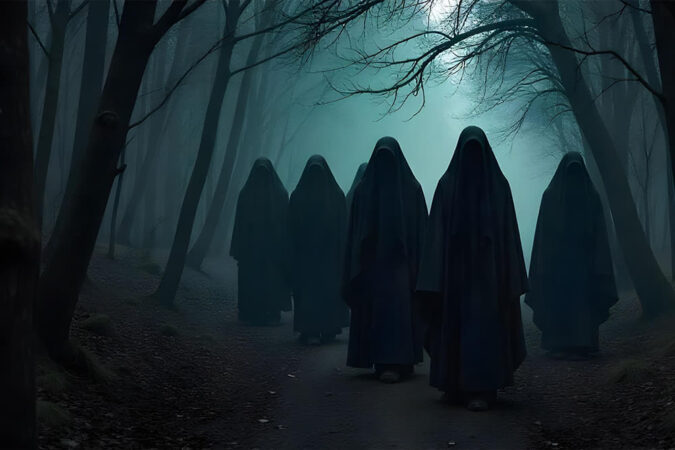Galicia, land of mountains, estuaries and cloudy skies, is also a land of mysteries and ancient stories. This region in northwestern Spain, rich in magical tales, has preserved a unique cultural and folkloric heritage that fascinates locals and travelers alike. In this article, we invite you to discover the legends of Galicia and get to know the hidden side of this place.
La Santa Compaña, the procession of the damned
One of the most popular myths is that of the Santa Compaña, a spectral procession of souls in pain that, dressed in black robes, wanders the country roads in search of people to drag to the afterlife.
The group is led by a cross-bearing mortal who forgets everything that happened during the night. This individual is said to be cursed and condemned to die of exhaustion due to the influence of the Santa Compaña, who will not let him rest. The only way to get rid of his position is to give the cross to another person who crosses his path.
There are several ways to protect yourself, such as drawing a circle on the ground with chalk, lying face down, praying or fleeing to a Cruceiro. The inhabitants of Galician villages fear this ghostly parade, as its presence is an omen of misfortune or even death.

Meigas, more than witches
The ‘meigas’ are a central figure in Galician folklore. There is a saying ‘eu non creo nas meigas, pero habelas hailas’ (I don’t believe in witches, but there are witches), which reflects the curious mixture of skepticism and respect with which many Galicians approach these subjects.
Meigas are different from the traditional concept of witches in other cultures, since in Galicia these characters can do both good and evil, depending on their intention.
A distinction is made between the healers, who use their powers to help the community with health remedies and spells to attract good luck, and the ‘chuchonas’ meigas, the evil ones who cause misfortune and suck the blood of their victims.
One of the most fascinating rituals related to these figures is the ‘queimada’ incantation. This is a ceremony in which the queimada is prepared, a drink made from brandy, sugar, lemon peels, coffee beans and herbs or fruits. The ritual consists of placing this concoction in a clay container and setting it on fire while reciting a spell, which serves to protect against evil spirits and meigas.
Ver esta publicación en Instagram
The songs of the Maruxaina
Galicia is a land of sailors and has many legends linked to the ocean that surrounds it. One of them is that of the Maruxaina, a mermaid that inhabited the island of Os Farallóns in Cervo.
Legend has it that this creature appeared on the rocks and attracted fishermen with songs. Its intentions vary depending on who tells the story. Some say that its purpose was to wreck boats and others that it came to warn of storms.
Its presence in Cervo is still felt today. In fact, every year they celebrate the feast of A Maruxaina, in which men must get into the water, seize the mermaid and put her on trial. After acquitting her of all charges, a feast is held on the beach.
Ver esta publicación en Instagram
The sacred mountains of Galicia
The Galician mountains and hills have been, since time immemorial, sacred places of worship. The Celtic and pre-Christian cultures of the area considered the mountains to be scenarios of power, and rituals were performed in them to connect with the world of the gods.
One of the most famous examples is Monte Pindo, known as the ‘Celtic Olympus‘. It is located on the Costa da Morte and is the scene of several legends. It is said that the spirits of Celtic warriors inhabit it and that its rocks hide symbols and mysteries yet to be deciphered. It is also said that its water is blessed by the gods and has magical properties.
Another place of great mystical charge is the Mount of San Cibrán, where the Romans built an altar to honor their gods, and Christianity later erected a chapel dedicated to San Cibrán. This mountain, near the sea, is one of the many places in Galicia where pagan and Christian beliefs coexist.
Ver esta publicación en Instagram
A pilgrimage of life and death
After Santiago de Compostela, the main pilgrimage point for Galicians is San Andrés de Teixido. This site is home to a sanctuary dedicated to St. Andrew and has a very curious legend that has made visiting it a must for all the inhabitants of the community.
The saying goes that ‘a San Andrés de Teixido, vai de morto o que non foi de vivo’. That is to say, whoever does not go to this place in life, will go once dead. The story states that the Apostle Andrew came to this lost valley by order of Jesus to install a sanctuary. In exchange for living in such a remote place, God promised him that everyone would go on pilgrimage to his place of worship, even those who did not do so in life. According to tradition, those who have never visited San Andrés de Teixido will do so three times reincarnated in other living beings before they can enter heaven. For this reason, the residents of the village are careful not to step on any insects so as not to interrupt the pilgrimage of a soul.
In case you want to visit this place while you have time, we leave you the route to follow from our hostel in Monte do Gozo.
Ver esta publicación en Instagram
The rocks that heal everything
In the heart of the Costa da Morte is Muxía, a fishing village with a very particular legend. This has to do with the stones located near the Sanctuary of Virxe da Barca and claims to have prodigious properties. It is the ‘pedra dos cadrís’ (kidney stone) and is a kidney-shaped rock that, if you pass under it nine times, will cure you of any problem.
The mythology surrounding this unique geographical formation tells that this stone would be the remains of the stone boat in which the Virgin arrived in Galicia.
Ver esta publicación en Instagram
Magical Galicia is a place where the invisible intermingles with the everyday. That is why its culture is so full of legends and beliefs that reflect its respect for superstitions and the unknown.



